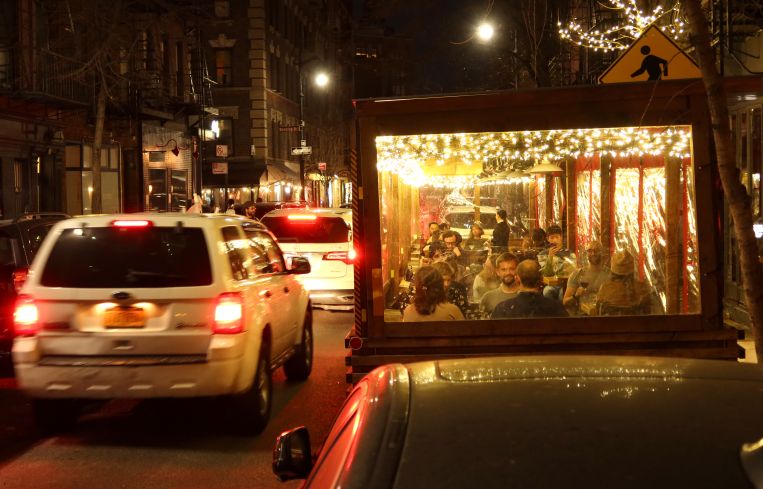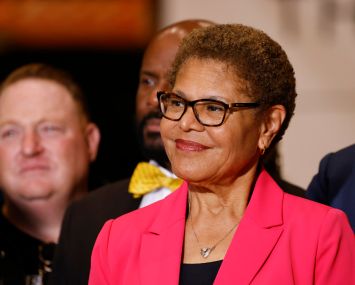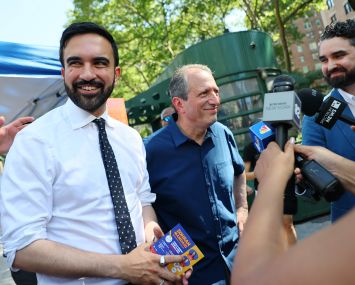New York City’s Restaurant Sheds Await Their Fate as Council Mulls
Seasonal? Year-round? Modular kits for everyone? A permanent ban? Many scenarios are on the menu.
By Aaron Short April 18, 2023 9:00 am
reprints
Susannah Koteen’s Harlem restaurant was nearly destroyed by the pandemic until two outdoor cabanas she built became a lifeline that saved her and her employees’ livelihoods.
Koteen had turned Lido into an uptown destination for Italian cuisine over the past decade before state-mandated coronavirus lockdowns three years ago abruptly forced her and her staff out of work. She intermittently reopened her trattoria in the spring of 2020 but had to close again from December to February 2021 during another COVID surge. She even applied for a federal PPP loan but it wasn’t enough to cover months of lost business.
So Koteen decided to utilize the city’s Open Restaurant Program that allowed the conversion of parking spaces to outdoor dining facilities, and she built two cabanas on Frederick Douglass Boulevard and 117th Street in front of her restaurant. The $35,000 structures had electricity, heat, speakers for music, and seated up to 20 people even during the winter months.
Now Lido is one of 12,800 New York City restaurants and bars currently operating outdoor dining sheds and dependent on their added revenue.
“We put a lot of effort into them. Even today people still really like to be outdoors,” Koteen said. “People see a busy restaurant on a Friday or Saturday night and think everything is good, but we went through three years of very difficult times. They help keep people employed. They’re important to us.”
The dining shed program’s future is uncertain. The city was supposed to finalize new rules that would make the program permanent, set fees for licenses, and allow the Department of Transportation to regulate sheds’ installation and removal. But the City Council has continued to tweak legislation governing sidewalk and roadway cafes as advocacy groups on both sides of the debate have mobilized to demand a more thorough reimagining of public space.
Hospitality industry leaders are frustrated with the delays.
“It’s past time for the mayor and City Council to finalize the outdoor dining legislation and move on from the emergency program,” said Andrew Rigie, executive director of the New York City Hospitality Alliance, which represents the city’s restaurants. “There needs to be clear guidelines and appropriate enforcement to ensure outdoor dining is properly maintained just like it was for many years before the pandemic.”
The pandemic years
When Gov. Andrew Cuomo and Mayor Bill de Blasio shuttered businesses and schools in late March 2020 as coronavirus cases surged across the city, restaurants had little choice but to comply.
Some restaurants had already experienced slowdowns in early 2020 when a COVID-19 outbreak occurred in parts of China and the federal government imposed travel restrictions from that country, but the state-mandated lockdown left hundreds of thousands of hospitality workers without jobs.
Some cafes temporarily kept their kitchens open to deliver takeout to jittery customers seeking comfort during an uncertain time. But even that move proved too risky as COVID-19 spread rapidly in March and April and restaurants instead boarded up their windows.
As the city slowly reopened in the summer and fall of 2020, restaurant owners and city lawmakers clamored for ways to allow more customers to eat and drink outdoors beyond the roughly 1,000 businesses that held permits for sidewalk cafes. By June, the de Blasio administration unveiled an outdoor dining plan that allowed restaurants to build semi-permanent sheds in backyards, on sidewalks and atop parking spaces near their entrances, and the mayor continued to extend the emergency order even as indoor dining returned.
City leaders claimed the Open Restaurants program, which converted 8,550 out of the city’s 3 million parking spaces to al fresco dining, saved 100,000 jobs.
Three years after being introduced to the city, outdoor dining remains stuck in regulatory limbo. After hosting a public hearing in February 2022, the City Council passed a zoning change allowing sidewalk and roadway cafes to operate in more neighborhoods outside of Manhattan. Opponents sued the city in July, claiming the mayor didn’t have the authority to continue running the outdoor dining program under COVID emergency orders since the pandemic had subsided. A state appellate court dismissed a previous lawsuit in October regarding the city’s environmental review of the program because permanent outdoor dining had not been finalized. The City Council still hasn’t held a vote on the bill.
That’s because council members have conflicting opinions about how to regulate the dining structures, and the council’s Committee on Consumer and Worker Protection has been assessing competing interests between restaurant owners, advocates and community groups. Bronx Councilwoman Marjorie Velazquez, who has been meeting with stakeholders and drafting an update of the bill, expects a vote to occur this year.
“Certainly some council members don’t want it at all in their districts, but others are literally begging me to keep outdoor structures and they explained how that investment has also produced so much more for their communities,” Velazquez said. “It’s a balancing act and part of that is understanding the districts, understanding people, and communicating over their fears.”
Advocates want the City Council to hurry up and pass legislation before a court decision puts outdoor dining in further — maybe terminal — jeopardy.
“We’re worried if the emergency order is knocked down we’ll be in a situation where many of the existing roadway structures would become illegal overnight,” said Maulin Mehta, the Regional Plan Association’s New York director who also leads a coalition supporting open restaurants. “The city would have to grapple with what that means with cleanup and to the small businesses that put a ton of money into these structures to survive during COVID.”
The opposition
Leslie Clark was in favor of outdoor dining when the first wave of the pandemic subsided.
But the longtime Greenwich Village resident had trouble walking through her neighborhood and sleeping at night as outdoor dining expanded over the past three years.
“In some areas on Friday and Saturday nights there’s no way to navigate except walking on the street, because restaurants take all the space except the subway grate,” she said. “Something that people have felt they wanted to give to neighborhood restaurants has turned into a blight on their lives.”
Clark helped form a coalition of neighborhood and block associations that sued the city last summer, arguing the executive order that birthed the program no longer applied because COVID-19 was no longer an emergency.
The alliance, known as the Coalition United for Equitable Urban Policy (CUEUP), released a blueprint arguing for specific changes to the law. The group proposed dismantling all sheds and decks for street sweepers to clean the roadways, capping outdoor licenses for each community board to 100 while restricting the number of licenses per block to one or two, barring outdoor heaters, and imposing fees for licenses based on the market value of the neighborhood to ensure that outer-borough restaurants pay less than those in Manhattan.
Council members are considering some of the group’s recommendations, but Clark also wants a new hearing to present proposals and air out any concerns before the council votes on the final bill.
“If this is such a great, big popular program, then what’s the problem with having a public hearing? Let people give their opinion,” she said. “When you have a bill that has not been given a proper public hearing run by emergency orders, that is not a public process. That’s a top-down imposition by the mayor.”
Future scenarios
The biggest sticking point in the bill’s negotiations has been how long dining sheds would remain outdoors during the year.
Neighborhood groups and some city officials want the structures to come down in the winter and be more easily removable for street sweeping and roadwork to occur.
Restaurant owners and public space advocacy groups prefer to keep sidewalk and roadway sheds operating year-round. They warn that a seasonal program would be unworkable because they don’t have the space to store barricades for vehicles, umbrellas and chairs, or the labor to keep moving them.
“You’re asking for a lot of extra labor at a restaurant, and it’s going to reduce incentive to participate,” Juan Restrepo, a community organizer with advocacy group Transportation Alternatives, said. “Taking a blunt hammer and dismantling a very successful program because of these concerns is a very dramatic response to a job-saving and quality-of-life-improving program as a whole.”
Council members are considering standardized design requirements for the structures, an idea some restaurants dislike since they have already invested tens of thousands of dollars in individual facilities. The Regional Plan Association’s Mehta isn’t opposed to a modular design that is easy to pick up and move when the city needs to clean the street. He worked with the American Institute of Architects’ New York chapter to propose a “kit of parts” of different components to make up the structure, including barriers, a platform, furniture, and canopy or umbrella options that protect diners from inclement weather.
“If you work to create a kit that can be adopted depending on street or business needs, we think there’s a way for businesses to take some form of a standardized part and customize it in a way that fits their specific geography or their creativity,” Mehta said. “If you do a blanket design that says no platform, that would limit some businesses from participating.”
Mehta stressed that the city must integrate a permanent outdoor dining program with other efforts to expand public space for city streets such as Open Restaurants, bike lanes, bus lanes and plazas. He wants to see long-term investment from the city in bollards, sandbags and other barriers to protect diners from speeding vehicles.
“It would do a disservice to the city if we treat outdoor dining in a silo, and the process of managing the program should reflect that change,” Mehta said. “We should share resources so not every restaurant is forced to provide a safety barrier and identify ways to reduce costs for individual restaurants.”
Times Square Alliance President Tom Harris, whose business improvement district helps manage one of the city’s most sought-after restaurant hubs on West 46th Street between Eighth and Ninth avenues, wants a permanent program to be fairer to all restaurants so more can participate. That could mean changing the zoning from “No Standing” in some areas and implementing a shared streets program that limits traffic at certain times of the day.
“Any permanent program must be equitable for all,” Harris said. “If the city is looking to allow this as an amenity they must change other parking regulations that allow more people to take advantage of this so you wouldn’t suffer whichever side of the street you are on.”
Whenever legislation ultimately passes, Councilwoman Velazquez wants to ensure the restaurant community won’t suffer because of a couple of bad actors.
“To me, the biggest impact is understanding who really kept our communities safe during the pandemic, and who kept us whole, and respecting that,” she said. “The restaurant community was a front-line worker for us. This ability to eat outdoors saved so many folks.”
This feature originally appeared as part of Commercial Observer’s Tenant Talk newsletter. Please consider subscribing to that and other newsletters here.
CLARIFICATION: This feature has been updated to reflect a July lawsuit by opponents of the outdoor dining program.



